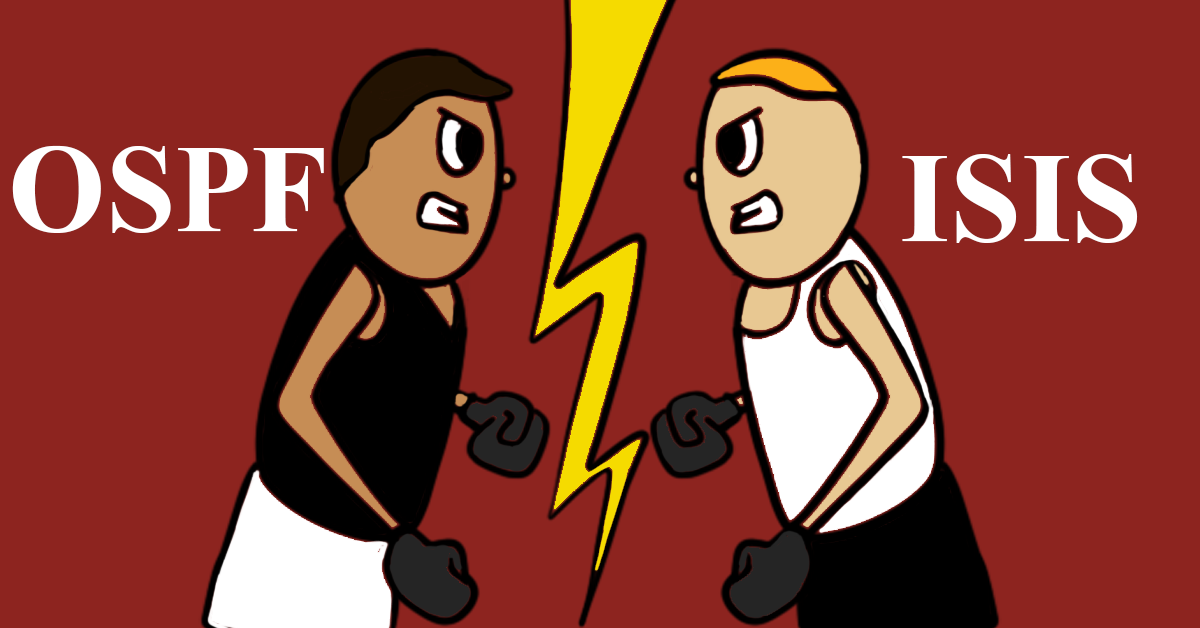Similarities:
- Both protocols use the Dijkstra Algorithm.
- Both Protocols utilize areas to segment the network.
Differences:
- The Administrative distance for OSPF is 110 whereas it is 115 for IS-IS.
- OSPF has the auto-cost feature that can calculate the cost automatically using a reference bandwidth, while the ISIS metric needs to be set manually.
For the record: the equivalent values based on a reference bandwidth of 1Tbps is:
| 400G | 3 |
| 100G | 10 |
| 50G | 50 |
| 40G | 25 |
| 25G | 40 |
| 20G | 50 |
| 10G | 100 |
| 1G | 1000 |
| 100 Mbps | 10000 |
- OSPF requires a backbone area (area 0) to route between areas. This concept does not exist in IS-IS; instead Level-2 routers can route between areas.
- To limit the amount of flooded information, OSPF utilizes a DR/BDR
ISIS creates a single pseudonode (Also known as DIS) to achieve the same purpose. - OSPF uses IP to exchange information (224.0.0.5 and 224.0.0.6)
ISIS uses MAC addresses to exchange information (01:80:c2:00:00:14, 01:80:c2:00:00:15 and 01:80:c2:00:00:05).
IS-IS Notes:
- Level-1 Routes are always preferred to Level-2 Routes
- Within a ring topology, Level-2 routers advertise a default route to Level-1 routers.
- Within an MPLS ISP environment and since most ISP equipment have enough resources to hold thousands of routes; it would not make much sense to use Level-1 as MP-BGP can’t benefit from default routes and you’ll need to (at least) redistribute the loopbacks from Level-2 into Level-1.
OSPF Notes:
- Forwarding Addresses needs to be learned via OSPF and can’t be learned externally (This is a behavior as per the RFC). and this behavior can prevent certain prefixes learnt using OSPF from being installed in the routing table.
MTU
While both protocols require the MTU value to be matching on the activated links (can be disabled in OSPF using the ignore-mtu command). It is more important in IS-IS that it is in OSPF
This is due to the fact that most OSPF updates are sent in LSAs that are carrying only one prefix (this is true for Type-3, 4, 5 and 7).
Type-2 LSAs can grow a bit larger .However, it is not reasonable for a Type-2 LSA to refer to a big number of neighbors on a broadcast link. and the only LSA that is like to grow large is a Type-1 LSA as it will include all the neighbors and the links that a router has and even then we are talking about an extremely big number of neighbors and stub links.
IS-IS behavior is different as it generates a single LSP per level and it contains all the prefixes in that level. Accordingly, IS-IS packets (LSP) can get too big pretty quickly.
Using Default MTU (1500 bytes), each IS-IS LSP can carry 121 IP prefixes and using fragment TLV the update can contain up to 256 fragments, each containing 121 prefixes, for a total of 30,976 prefixes; this number can be much larger if Jumbo Frames (9200 Bytes) are enabled where approximately 750 prefixes can be carried within a single LSP and multiplying that by 256 fragments IS-IS will be able to exchange the information of more than 190,000 prefixes
IS-IS uses padding TLVs to detect MTU mismatches by increasing the hello packets size which would prevent the adjacency from coming up if an MTU mismatch is found.
This behavior is what allows IS-IS to fragment the updates; keeping in mind that IS-IS does not use IP to exchange information and the normal fragmentation process does not work with it so it benefits from the MTU detection mechanism and distributes routing information into more LSP once it detects that the shared updates will not fit within a single LSP.
